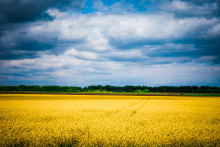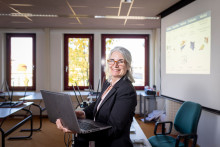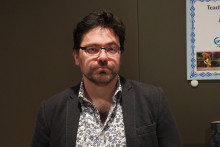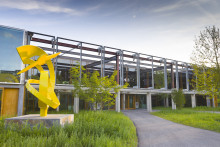The project was initiated by Polish Earth Observation company CloudFerro shortly after the Russian invasion of Ukraine this year. During the UT talk tomorrow, experts from CloudFerro and professor Nataliia Kussul from the Kyiv Polytechnic Institute will present the current status of EO4UA. UT scientist Serkan Girgin (Head of Center of Expertise in Big Geodata Science) and Jędrzej Bojanowski explain more about the initiative.
Why was the project started?
Bojanowski: ‘The main idea was to help monitor Ukrainian environment, especially food production and forestry. We wanted to support our Ukrainian colleagues and academics. Due to the war, they lost infrastructure and data. As data provider, we felt obligated to help. We wanted to provide help immediately and efficiently, and so we started reaching out to anyone who could contribute. Quickly we were able to reach a lot of institutes and agencies, such as the EC Joint Research Centre and the European Space Agency.’
How does the initiative work?
Bojanowski: ‘We provide processed earth observation data ready for analysis, which anyone – such as Ukrainian and international authorities – can use for their own purposes. We focus on providing satellite data to assess impact of the war on agriculture, and therefore food security, but it can also be useful for monitoring deforestation, forest fires, hydrological changes and infrastructural damage. On our geoportal you can visualize products generated by our partners, which allows you to see, for example, which agricultural areas have been affected, what is growing and where. This is crucial for monitoring food security. Ukraine is a large agricultural producer and many countries rely on its crops. The ongoing conflict therefore poses a huge risk.’
Is the University of Twente involved in the project and how?
Girgin: ‘There are many collaboration options. The data produced within the initiative offers a lot of opportunities, but needs to be combined with the right expertise – and ITC faculty at the UT is well-known for its expertise on geo-information science and remote sensing. One of the main knowledge domains of our faculty is food security, which could be very useful in this context. But we don’t want to limit the involvement to ITC. It’s a good opportunity for all UT faculties. For instance, many scientists at the UT are working on artificial intelligence (AI). The data provided within EO4UA is suitable for analysis using machine learning and AI. I imagine we could come up with many innovative ideas to help Ukraine with our expertise.’
Bojanowski: ‘Absolutely, there are no limitations. We are essentially a group of institutes and companies that want to offer their expertise in time of crisis. Not because of science but because of real-life problems that need to be solved.’
What do you hope will be the main contribution of the initiative?
Bojanowski: ‘We hope this helps our Ukrainian colleagues to keep working. Local infrastructure cannot be used, but thanks to this initiative they can keep doing their work. We also wish that their work will benefit significantly from the data and services provided by other members of the initiative. Hopefully this serves as an inspiration for other projects and shows the benefits of fast collaboration and finally the idea of open data.’
Girgin: ‘It would be wonderful if, once the conflict is over, we could see how the local authorities used the initiative’s input. We know that the data sets are being used, but in some cases we don’t know how. Having the feedback and acknowledgment would serve as a big motivation to all the partners, hopefully also including the UT.’







